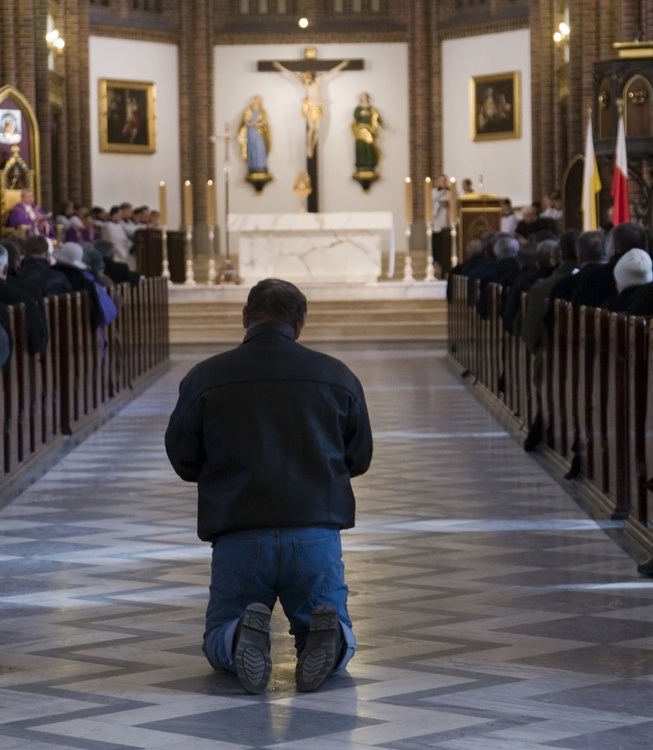
I bend my knees to God.
That is, I worship Him and acknowledge that He is greater than I. Especially when I am asking Him for something.
Does whoever kneel, pray? These two should not be equated . . .
Kneeling . . . . This posture most associated with praying. Probably because we very rarely kneel before people these days. Oh, it happens that a young man kneels before a young woman, but in front of some lord or ruler? No, not these days. And perhaps that is why we often put an equals sign between kneeling and praying. But it isn’t so, as I mentioned when discussing the postures of standing and sitting. It is obvious though that you can kneel to pray. And that this posture has its significance.
The knee is a most curious part of the human body, if it’s about their symbolism of course. From time to time when reading the Bible, we come across the phrases “weakened knees”, “trembling knees” or something similar. You know what’s going on here. Sometimes we ourselves say “to go weak at the knees”. The meaning of these phrases is obvious “I can hardly stand”. Due to weakness or fear. To kneel is somethings else: it is bending your knees with the intention of bending them.
In relationships between people, kneeling before someone, especially authorities, was always an expression of respect and reverence for them. It was the expression of a sort of humility. And it also has a similar meaning in the religious life: bending the knees and putting them on the floor instead of the feet is showing God respect and reverence (that doesn’t mean that standing or sitting shows a lack of it); it is a recognition that the One before I kneel is much more important than I am. Traces of such thinking are found in the Bible. When the psalmist exclaims: “O come, let us worship and bow down, let us kneel before the Lord, our Maker!” (Ps 95:6). Or when Saint Paul writes of the reverence he gives to God, he puts it in these words: “For this reason I bow my knees before the Father, from whom every family in heaven and on earth is named” (Eph 3:14-15). Perhaps most beautifully in the excerpt from the Letter to the Philippians in the hymn about the humiliation of Jesus. Explaining how much He humbled Himself is also an announcement of His exaltation:
Therefore God has highly exalted him
and bestowed on him the name
which is above every name,
that at the name of Jesus
every knee should bow,
in heaven and on earth and under the earth
(Phil 2:9-10).
So, kneeling before God, I give Him reverence.
Kneeling is also an expression of an earnest plea. An attitude that is rarely seen between people today. In relation to God – it is seen much more often. When we very much want something from God, our knees themselves want to bend, they want to take the place of our feet, if only God will hear us. It is an expression of humility, recognising who is the One before whom I kneel. I know that He can hear my request, but I plea for Him to be willing.
During the Eucharist we basically kneel twice. The first time during the transubstantiation. To distinctly worship God, who in that moment takes on the appearance of Bread and Wine. The second time, when the priest shows the Body of Christ, recalling two New Testament pronouncements. First the words of John the Baptist “Behold, the Lamb of God, who takes away the sins of the world”. Then the voice of the author of Revelation was told to write down: “Blessed are those who are called to the supper of the Lamb!”. And we reply with a paraphrase of the words of the Centurion asking for his servant to be healed: “Lord, I am not worthy for you to enter under my roof, but only say the word and my soul will be healed”. At that moment it is both the worship of the Lamb of God and an earnest request that He make us worthy to eat the “Bread of Eternal Life” and drink the “Chalice of Eternal Salvation”.
However, so as not to equate worship of God with kneeling, it is worth realising that the Christian, according to what Saint Paul wrote in relation to God, “is no longer a slave but a son” (Galatians 4:7). It would be strange if the Father expected that His children always kneel when they address Him. Taking a standing posture or even sitting is not insulting Him. It is beautiful to see the above-mentioned scene when we kneel before the Lamb recognising that we are not worthy for Him to come to us, but He fulfils our plea and healing our souls makes us worthy of Himself; He lifts us and lets us come to His table so that we can be nourished by Him. Yes, I am not worthy, but He makes me worthy. I now don’t have to fall to my knees before Him, I choose to, for He has lifted me up.